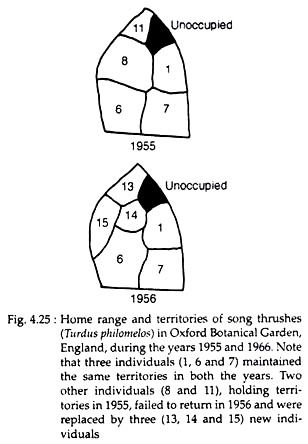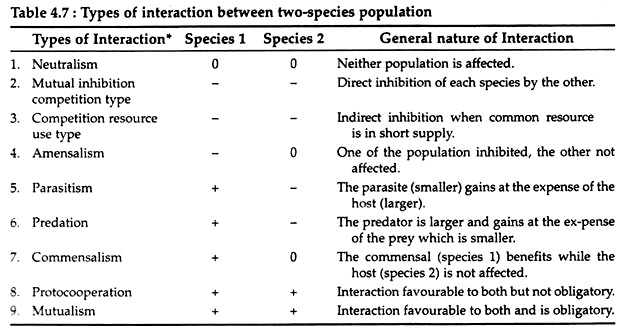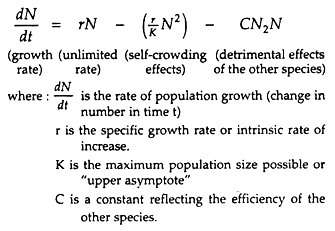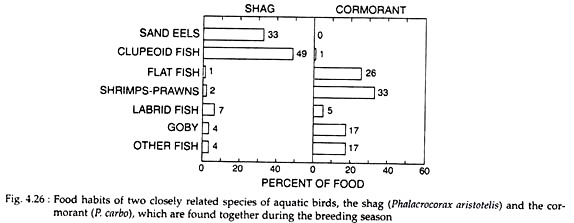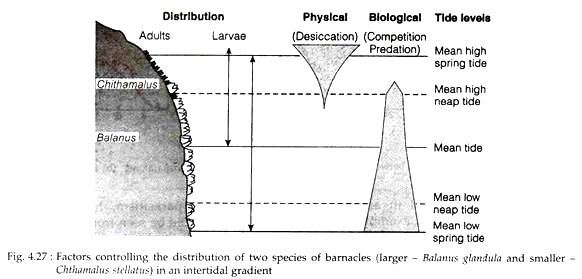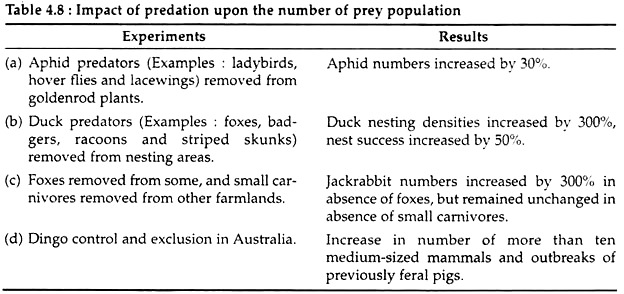In this article we will discuss about the intraspecific and interspecific interaction between organisms.
Intraspecific Associations:
In intraspecific association individuals are quite similar in their resource requirements. This may often lead to intense competition. Intraspecific competition is a major force in ecology. To overcome or cope with competition, intraspecific competition may lead to behavioural adaptations such as dispersal and territoriality.
Also, by depressing the fitness of individuals in a crowded population it may influence fundamental processes like fecundity and mortality.
Reproduction:
ADVERTISEMENTS:
In sexual reproduction the first phase is the selection and location of mate. The location and attraction of the sex partner may occur by the advertisement by one sex of its whereabouts using scent (pheromones of female moths) or sound (croaking or growling) or sight (lights in glow-worm). The selection of the mate may result in competition between individuals of the same sex (either males for females or rarely females for males).
For example, in deer, monkey, lion etc. males fight for harems of females. In the other case, females choose the male which they see as most attractive. This is seen in bird species where the males are colourful (peacock, birds of paradise etc.). Females compete with each other for males in case of jacanas (small water birds).
Care of offspring:
ADVERTISEMENTS:
Off-springs are generally cared by their parents which includes feeding, guarding, keeping them warm and transporting immature individuals. Care of offspring may be taken by females only (leopard) or by both parents (birds, where both parents may hunt for food to feed the nestlings), or rarely by older siblings.
In the latter case, it may occur among colonial insects such as termites or in a creche system where one or two adults (example, naked mole rat) may remain with the offspring.
Social behaviour:
Social behaviour is witnessed among some insects such as bees, wasps etc. Here social interactions are altruistic (helping behaviour) and centres around finding food, guarding and defence of territories, cleaning of hives and caring of young and more vulnerable members of the group.
ADVERTISEMENTS:
Competition:
Competition occurs between individuals within a species for resources such as food, space, light, water, mineral nutrients, shelter etc. Competition can occur at any time during the life cycle — between sperm or actively growing pollen tubes for the chance to fertilize an egg; between embryos in the womb for parental nutrients; between seedlings for light and space; between off-springs in the same litter or different litters in the same social group; between adults and young (example between trees and seedlings on the woodland floor; between male lions and young cubs of the previous male).
Effects:
1. Density dependence:
The relationship between fitness and population size is described as density dependence. A major regulatory factor is negative density dependence, where fitness declining occurs as population density increase within a species due to intraspecific competition. As the number of individuals increases it results in increase of mortality rates and the declining of birth and growth rates.
2. Dispersal:
When competition is intense, organisms tend to disperse (move) away from the area of high population density. Even in species that are sessile for most part of the life cycle, do usually have a mobile dispersal stage, like they may be carried by winds, water currents, on the fur of animals etc.
ADVERTISEMENTS:
Most sessile marine organisms have a mobile larval stage. Some species produce special dispersal morphs. While in some mammals, there is sex bias in dispersal, for examples male lions leave the family group but their sisters remain with their mother.
Dispersal accounts for:
(i) Permits possible escape,
(ii) Provides a mechanism by which individuals avoid the costs of inbreeding.
(iii) It is often a risky activity as it involves the location of a suitable habitat.
(iv) Tendency to disperse may depend upon the species’ competitive ability.
3. Territoriality:
Territories are areas of space competed by individuals or by groups of animals. It is seen in insects, birds (Fig. 4.25) and mammals. The territory boundaries are maintained due to active interference between individuals. Generally an individual or mating pair defend own territory, but social animals like gray wolves may defend a common territory.
Territory size is determined by the balance of costs and benefits. As the territory size increases, both may increase till the costs of maintaining the territory will outweigh any benefits.
Territories may be of different types, such as:
(a) General purpose territories established by many songbirds etc., in which almost all activities occur, including feeding mating and rearing of young.
(b) Specialised territories are leks where closely aggregated male territories occur for the purpose of breeding and are often short lived. Lekking occurs in amphibian (natterjack toad), birds (black grouse) and mammal (fallow deer).
Territoriality accounts for:
(i) Improved winter food availability (example: great tits).
(ii) More attractive to mates. Female red-winged blackbirds choose males on the basis of territory quality.
(iii) Provide more food to their youngs.
(iv) Territories increase as resources become scarce.
(v) Have reduced predation risk. In ground squirrels, pairs with large territories are less likely to cannibalize their young.
(vi) Certain portion of the population called ‘floaters’ or ‘satellites’ e.g.. elephants etc., cannot secure for themselves a territory. These satellite individuals are rarely able to successfully mate females
4. Self-thinning:
In sessile organisms, when even-aged group of competing individuals cannot escape, competition results in the survival of fewer individuals of larger and larger size. Such a process is described as self-thinning.
Interspecific Association:
Interspecific association results between two different species; often those species compete with one another in terms of food, space etc.
Types of Association between Two Species:
Generally three types of association may be expected — neutral (0) interaction (no gain no profit basis), favourable (+) interaction (benefit or gain) and unfavourable (-) interaction (inhibition or loss). Based on this, population of two species may theoretically interact in the following 9 basic ways as given in Table 4.7.
The population interactions given in Table 4.7 are likely to occur in any large-scale biotic community (forest, wet land, grassland etc.). For a given species pair, the types of interaction may change under different conditions — may exhibit parasitism at one time, exhibit commensalism at another and be completely neutral at still another time.
The growth of one species population is influenced by another population and this can be expressed by a term that modifies the growth of the first population. During competition the growth rate of each population is equal to the unlimited rate minus its own self-crowding effects (this increases as the concerned population increases) minus the detrimental effects of the other species population (N2). It also increases as the numbers of the concerned population (N) and N2 increases. Thus, determination of growth rate of population can be summarised as follows:
If ‘C’ (detrimental effect) is small for both the population then the depressing effects of interspecific are less than the intraspecific (self-limiting) effects. Thus, the growth rate and the final density of both the species would be depressed slightly and both species would be able to live together as the competition within the species would be more important than the effects of the other species.
If C is large then the species exerting the largest effect will eliminate its competitor or force it to leave the habitat. Thus, species which have similar requirements cannot leave together as competition would become stronger and stronger causing one of them to be eliminated.
Contrary to the above, if two species population interacting with one another have beneficial effects on each other, then a positive term is added to the growth equation instead of the detrimental effect. In such cases, both population grow and prosper. They reach equilibrium levels that are mutually beneficial.
1. Neutralism:
When two different species population are not affected by the association with one another is called neutralism. For example, grass carp and catla residing on the surface of a pond do not affect on another as their food habits are quite different. Grass carp feeds on macro vegetation while catla feeds on zooplankton.
Another example (Fig. 4.26) is in the two closely related species of aquatic birds in England – the shag (Phalacrocorax aristotelis) and the cormorant (P. carbo). Although they are found together during the breeding season, they do not affect one another as they feed on entirely different kinds of fishes. Thus, the niche of the two species is different.
2. Competition:
Competition is an interaction among two organisms utilizing a limited resource (example: food, space etc.) resulting in reduced fitness in the competing individuals. In interspecific competition any sort of interaction takes place between two or more species populations that adversely affect their growth and survival. This often brings about an ecological separation of closely related species and is known as the competitive exclusion principle or Gause’s principle.
Interspecific competition may also result in equilibrium adjustments by two species. It is observed that closely related species having similar habits or life forms often do not occur in the same places. If they do, then they use different food or are active at different times or they tend to occupy somewhat different niches.
Ecological niche does not mean only the physical space occupied by an organism, but it also refers to the energy source, period of activity etc. No two species can have exactly the same niche although if they are closely similar they may have virtually the same niche requirements. Also, severe competition may occur where niches overlap to a certain extent.
Interspecific competition is of two kinds:
(1) Interference competition
(2) Exploitation competition
A. Direct or interference competition:
This type of competition occurs when two species come into direct contact with each other. Direct competition occurs more frequently in the animal world, from simple filter-feeding protozoans and cladocerans (they usually compete in gathering food) to vertebrates (they have elaborate behavioural patterns of aggression and territoriality).
Connell’s (1961) classic study of interference competition was conducted on the rocky coast of Scotland, where two species of barnacles typically occupy different locations in the intertidal zone. The larger species, Balanus glandula, occurs in the lower intertidal zone than the smaller species Chthamalus stellatus (Fig. 4.27).
The larger species, Balanus, was seen to be restricted at the lower part of the zone as it could not tolerate long periods of exposure at low tide. On the other hand, the smaller species, Chthamalus, was forced to occupy the lower zone due to competition with the larger species and by predators that are more active below the high tide mark.
Thus, the physical stress of desication was the main controlling factor in the upper zone, while interspecific competition and predation were more important factors that controlled the lower zones. However, Connell found that the larvae of the two species of barnacles settled over a wide range of the intertidal zone. On becoming adult they survive in a much more restricted range.
B. Indirect or exploitation competition:
It occurs when one species exploits a resource (such as food, space etc.) in common with another species but without direct contract with that species. This indirect competition in exploitation of resources can provide a competitive advantage for one species against another.
A clear case of exploitation competition was provided by one of Gause’s (1932) original experiments with ciliates. Paramoecium caudatum and Paramoecium aurelia, when grown separately in yeast medium (Fig. 4.28). P. aurelia was found to have fasten rate of increase than P. candatum. When both species were added to the same vessel, P. aurelia dominated the mixture and eventually P. caudatum died out (Fig. 4.28c).
Neither species attacked the other nor secreted any toxic substances. It is because P. aurelia population simply had a more rapid growth rate (higher intrinsic rate of increase) than P. caudatum and thus “out-competed” them under the existing condition of limited food resource.
3. Amensalism:
Amensalism, termed by Haskell (1949), is a -/0 interaction in which one species is harmed and the other unaffected. Here one organism harms the other through a byproduct formed by its activities.
Humans are involved in amensalism with many organisms. For example, lichens die due to air pollution produced by human activities. Similarly, bees die when the health department sprays insecticides to kill mosquitoes.
Another case of amensalism is seen in bird colonies of great blue herons and great egrets. These bird colonies produce guano that affects the vegetation below it, including the killing of seedlings of nest trees. Lawton and Hassell (1981) refers to the above interaction as asymmetrical competition. Amensalism is viewed to be just one evolutionary step from interactions such as allelopathy (-+).
4. Positive/Negative Interactions:
Negative interactions (-/+) such as herbivore predation, parasitism, allelopathy, results in harmful effect on the growth and survival of one species population and positive or beneficial effects on the other.
In a relatively stable ecosystem, the negative effects tend to be quantitatively small. Natural Selection tend to lead either to a reduction in detrimental effect or to the elimination of the interaction altogether.
Thus, severe depression of a prey on host population by the predator or parasite population, often lead to the extinction of one or both the population. The severity of impact occurs when the interaction is of recent origin. Over long term of association, parasite-host or predator-prey interactions often lead to coexistence.
Predation, parasitism, herbivore and allelopathy should be seen from the population and community levels rather than from individual level. Predators, grazers, parasites and allelopaths do certainly kill or injure the individual or secrete toxic chemicals, but they in some respect do reduce the growth rate of their target populations or keep in check the total population size. Thus, predators and parasites help to keep herbivorous insects at a low density so that they will not destroy their own food supply and habitat.
Another thing of interest are those organisms that are intermediate between predators and parasites—the so-called parasitoid insects. These organisms like the predator can consume the entire individual prey, yet they have the host specificity, high biotic potential and small size like that of the parasite. These facts have encouraged entomologists to use them for controlling insect pests.
However, the use of large, un-specialised predators have often resulted in detrimental effect. For example, mongoose (Herpestes edwardsi) was introduced in the Caribbean Islands to control rats in sugarcane fields. This had resulted in severely reducing the ground nesting birds rather than the rats. Thus, control can be effective only if the predator is small, is specialised in its choice of prey and has high biotic potential.
Human beings, through manipulation of the ecosystem, are slowly learning how to be a prudent predator. They know now, when and how much biomass is to be harvested so that the system or relationship is not damaged.
Often one-species models prove to be oversimplified. It possesses both challenge and danger. One-species harvest systems and monoculture systems (one crop rotation) are inherently unstable because, when stressed, they are vulnerable to competition, parasitism, disease, predation and other negative interactions.
Another point of interest is the stress of predation on harvest, which often affects the size of individuals in the exploited population. For example, in pond ecosystem, large species of zooplankton are replaced by smaller species when zooplankton-eating fishes are introduced into it, which previously lacked such direct predation.
A. Allelopathy:
When organisms release chemicals into the environment with unfavorable effects on other species, this type of interaction is referred to as allelopathy. The term allelopathy was coined by an Austrian botanist, Hans Molisch, in 1937, although the effect was known for a much longer time. Quite a number of allelopathy cases are found in nature.
A few of them are:
(i) Walnut trees cause headaches in humans and cause injury to any plant planted in its vicinity. The inhibitory effect is caused by a compound called juglone, a quinone, which makes ones fingers brown when one handles walnuts.
(ii) Microcystis, a blue-green algae produces a toxic substance called hydroxylamine, which kills the fishes and the cattle which drink this water.
(iii) The algae Chlorella vulgaris produces a toxin called chlorellin, which is toxic to other algal species.
(iv) Cymnodinium, the marine dinoflagellate, when in large numbers, emits glowing red light and is referred to as red tide. This organism produces a toxin that kills fishes and other marine animals. In 1946-47 this red tide caused large scale deaths of fishes through an area of several thousand square miles in the west coast of Florida.
(v) Fungi produces harmful substances like penicillin, streptomycin, aureomycin etc. that kill bacteria and virus.
(vi) Sponges contain a variety of bio-tonic chemicals which affect everything from bacteria to fish. These chemicals are released in water and inhibit the settling and growth of other potentially competitive invertebrates.
Allelochemicals recognised so far are terpenoids or phenolics, although several other kinds of compounds may potentially be involved. These chemical compounds reduces nutrient uptake, inhibits respiration, interferes with growth hormone metabolism etc.
These effects reduce the survivality of the other species. Thus, allelopathy has been suggested to be the cause of a variety of patterns including the composition of climax communities. Allelopathy probably has good potential in agriculture. The allelochemical could possibly be used as herbicides. These herbicides would be less harmful in the environment than most current herbicides.
B. Predation:
Predation can be defined as the consumption of all or part of another individual (the prey). True predators are those who kill their prey soon after attacking them, while grazers are those who consume only a part of the prey or few individuals of the prey. Again, predators may be divided into herbivores (consuming plant tissue), carnivores (feeding on animal tissue) and omnivores (feeding on both plant and animal tissue).
Prey (the effector) defend themselves by structural devices (the thick shell of a coconut, snail or tortoise), plants primarily use chemical devices for defense, while animals adopt a variety of behavioural strategies (fight, run, hide camouflage etc.) Some animals do adopt protective toxins, for example, puffer fish and cane toad.
Predators vary in their nature of diet. Some species called specialists are extremely selective, concentrating exclusively on one type of prey. Others are generalist, being able to feed on a number of prey species.
Herbivores are more specialised than carnivores, concentrating on a narrow range of related plant species with similar defense chemicals. Generalist or polyphagous herbivore species feed on a range of plant species but avoid the more toxic parts or individuals.
Carnivores, on the other hand, are either monophagous, feeding on one prey type, or oligophagous—feeding on few prey types. It is seen that large carnivores and herbivores generally have a wider diet range. Thus, most herbivorous mammals are mainly polyphagous except a few who are monophagous. Example, the giant panda, a bamboo specialist, and the koala, a eucalypt specialist.
Escaping predation:
Animals living, feeding or moving together in groups have a better chance of escaping predation. When several mammals or birds remain together or feed together, there is every possibility that one of them will be looking at the right direction to notice an approaching predator. This would instantly be communicated to the rest of the pack and the prey would be able to avoid its attacker. Such mutual vigilance would be adaptive.
It has been seen that groups of animals spot predators quicker than single animals. This allows groups to obtain food more efficiently than solitary individuals. Thus, mutual vigilance allows each individual in flock to get by with reduced vigilant time, allowing more time for foraging. It has been seen that ostriches raise their heads three or four times a minute while feeding alone, but less than twice a minute while feeding in groups of three or four.
Plant defence:
To escape from predation, plants defend themselves in two ways:
(i) Toxicity and un-palatability, and
(ii) Defensive structures.
(i) Toxicity and un-palatability:
A number of chemical substances are used by the plant kingdom to defend themselves against attacks from predators. These substances may be either directly toxic or may reduce the food value of the plant.
(ii) Defensive structures:
A variety of defensive structures exist in plants, from small hair on the leaf surface (which may trap insects and other invertebrates) to large spines which deter mammalian herbivores.
The impact of predator on prey population:
Predators may or may not regulate the population size of their prey.
These are discussed as follows:
(i) If the effect of any one predator is considered, which is a small component of the total mortality causes affecting a prey species, then removal of the predator will have only a minor effect.
(ii) Often predation removes an excess of animals above the number that the environment can sustainably support. In such case there will be no impact on the final prey population size. For example, banning of toxic pesticides in Wytham Wood, England, resulted in increased mortality (1% to over 30%) of great tits (Parus major) due to hawk predation, yet there was no marked reduction in the number of great tits. This was due to the fact that the key factor limiting population size in this species was not predation but the scarcity of nest-holes.
(iii) When any predator (new) is introduced into any ecosystem, it causes marked impact on the prey numbers, as they are greatly disadvantaged because they have no evolutionary history of predation and, thus, have not evolved any appropriate responses. Such an effect was seen when brown tree snakes were introduced in the Pacific Island of Guam. It caused extinction or considerable reduction in the number of ten native bird species.
(iv) In some cases, long-term exposure to predators have strong impact on the prey population, as given in Table 4.8:
5. Positive interactions:
Positive association between two species population that results in beneficial effects are widespread. Positive association are A. Commensalism (+/0), B. Protocoope- ration (+/+) and C. Mutualism (+/+).
A. Commensalism:
The term commensal was coined by P. J. Van Beneden (1876). It is a simple type of positive association and probably represents the first step toward the development of mutual beneficial relations (Table 4.7). Commensals live on or around individuals of some other species (host) and derive benefit from the association.
Previous view of commensalism can be best said in the words of Van Beneden: “The commensal is simply a companion at the table”.
A few such examples are given:
(i) Vulture, a scavenger, feeds upon the leftovers of a kill of large carnivores (tiger, lion etc.)
(ii) The fish, remora, has a suction cup on the top of its head. With its help it attaches itself to a shark and travels with it. It eats the leftovers of the bigger fish’s meals.
(iii) A number of communal fish, clams, polychaete worms and crabs lives by snatching surplus or rejected food or waste materials from the host.
Commensalism is now used in a broader sense to refer to coactions. It is not restricted only to access of food but also to all other gains.
Some examples of gain other than food are:
(i) Many “uninvited guests” take refuge in the burrows of worm, shellfishes and sponges. They, however, do neither harm nor do well in return. Oysters house small, delicate crab in their mantle cavity.
(ii) Deer mice use old birds’ nest for their own.
(iii) Prairie dog burrows are used as nest sites by burrowing owls.
(iv) Dispersal by animals is often communalistic.
Commensals, in general, are not host-specific although a few may be found to be associated with only one species of host.
B. Proto-cooperation:
Proto-cooperation or facultative cooperation is an association when both the species population benefit but their relations are not obligatory. It is often considered to be a short step from commensalism to mutualism.
W. C. Allee (1951) was the first to throw light on this type of association and stressed the importance of cooperation and aggregation among species. Allee believed that cooperation between species is found throughout nature.
He sited an example of proto-cooperation between crabs and coelenterates. The coelenterate attaches itself on the back of the crab (Sometimes the crab itself plants if on its back) and provides it camouflage and protection (Coelenterates have stinging cells). In return, the crab provides the coelenterate with transport and food (when the crab captures and eats another animal).
The above example is not obligatory as the crab does not absolutely depend on the coelenterate, and vice versa. A further step would result in mutualism when each population would become completely dependent on the other.
C. Mutualism:
It is a positive reciprocal relationship between two individuals of different species populations, where both the parties are benefited and neither can survive under natural conditions without the other. It ultimately results in increased fitness for both parties.
